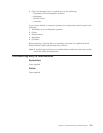
While many conditions can produce a Bad Stripe Table entry, the most common
cause is an error accessing one of the stripe units within a stripe of a critical logical
drive. A single stripe unit failure is correctable and recoverable but two or more
failures within the same redundant RAID stripe are not.
For example, in a critical RAID-5 array, in which one of the drives in the array is
defunct, a stripe will be marked bad with an entry in the BST if a non-recoverable
media error occurs when accessing one of the other drives of the array.
Once an entry is logged in the BST, the controller will return an error code to the
driver whenever the host system tries to access a Logical Block Address (LBA)
within the affected stripe. This is one immediate indication that some part of the
logical drive is unusable.
Note: It is not possible to correlate the bad stripe with a specific file in the
operating system.
Action:
v Check the ServeRAID Manager event logs to identify the affected logical
drive(s).
v Because the data has been lost, the only way to recover from this condition is to
do the following:
1. Delete the array.
2. Recreate the array and its logical drives.
3. Restore the data from backup media.
v
The alternative is to take the entire logical drive offline, thus resulting in the loss
of all data contained on that logical drive.
v To minimize the risk of lost data, be sure to schedule frequent periodic backups.
Exception removing timer from active queue
Explanation:
v There is no configuration on any of the physical drives that are attached to the
controller.
v There are no physical drives attached to the controller.
v The controller does not support one or more features of the drive configuration.
Action:
If you have physical drives attached to the controller and the physical drives
contain a valid controller configuration, complete the following steps:
1. Verify that the controller, cables, and physical drives are installed properly.
2. Verify that there is power to the physical drives.
3. Retry the command.
4. If the command still fails, restart the server and retry the command.
If
the problem persists, the configuration data has been lost. Reconfigure the
controller using the ServeRAID Manager.
Chapter 5. Troubleshooting ServeRAID Manager 245


















